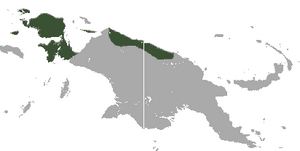Grizzled tree-kangaroo facts for kids
Quick facts for kids Grizzled tree-kangaroo |
|
|---|---|
 |
|
| Conservation status | |
| Scientific classification | |
| Genus: |
Dendrolagus
|
| Species: |
inustus
|
 |
|
| Grizzled tree-kangaroo range | |
The grizzled tree-kangaroo (Dendrolagus inustus) is a special type of marsupial that lives in trees. It belongs to the Macropodidae family, which also includes kangaroos. You can find this animal in the forests of northern and western New Guinea. It also lives on some islands near New Guinea.
Contents
What it Looks Like
The grizzled tree-kangaroo can grow to be about 75 to 90 centimeters (about 2.5 to 3 feet) long. Male tree-kangaroos are usually bigger than females. They can weigh between 8 and 15 kilograms (about 17 to 33 pounds).
This animal looks a bit like a kangaroo that lives on the ground. It has a small head with a flat nose. Its arms are very strong, which helps it climb trees. Its back legs are long, and its feet are big for an animal that lives in trees. The toes have strong claws, and the fourth toe is often longer than the others.
The tail is bushy and round, but it can be hairless near its base. The tree-kangaroo uses its tail to help it balance when climbing. Its fur is usually a color between charcoal gray and chocolate brown. Its belly is lighter in color. The ears are black, and its toes and tail are dark.
Where it Lives and Its Home
The grizzled tree-kangaroo lives in the warm, wet rainforests of northern and western New Guinea. It can be found in areas up to 1,400 meters (about 4,600 feet) above sea level.
Its home includes places like the Foja Mountains and the Bird's Head Peninsula. You can also find it on islands such as Yapen, Waigeo, Misool, and Salawati. It lives in both old, untouched forests and forests that have grown back after being cut down.
Life and Habits
The grizzled tree-kangaroo spends most of its time high up in the forest canopy. It can jump easily from one tree to another. Sometimes, it will come down to the ground.
When it sleeps, it rests on a horizontal tree branch. It eats leaves, fruits, and bark from trees. Its diet includes leaves from plants like Schuurmansiella angustifolia, Gnetum, Tetracera, Elatostema, and arums. It also enjoys the leaves and fruit of fig trees.
Not much is known about how these tree-kangaroos have babies. It seems they have one baby about once a year. The baby stays in its mother's pouch for around nine months. Scientists have seen mothers with young babies in March, June, and December. There has even been one record of twins!
Why it Needs Our Help
The IUCN says the grizzled tree-kangaroo is a "Vulnerable" animal. This means its population is decreasing, and it could be in danger. It is not a common animal, and we don't know exactly how many there are.
Local people sometimes hunt these tree-kangaroos for food or to sell as pets. Their homes are also being lost. Forests are being cut down for small-scale agriculture (small farms) and to plant oil palm trees.
The tree-kangaroos living in the northern coastal mountains are especially at risk. However, some communities in those areas are working to protect these amazing animals. The grizzled tree-kangaroo is also listed in Appendix II of CITES, which means its trade is controlled to prevent it from becoming endangered.
See also
In Spanish: Canguro arborícola gris para niños


